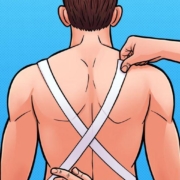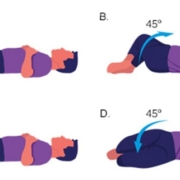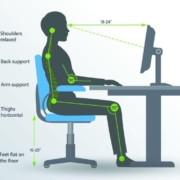5 Surprising Ways Your Feet Influence Your Spine Health
When it comes to maintaining a healthy spine, most of us focus on exercises, posture, and ergonomic furniture. However, what if we told you that the foundation of your spine health lies right beneath you? Your feet, often overlooked in the grand scheme of wellness, play a pivotal role in supporting your entire body. In this listicle, we’ll explore five surprising ways your feet influence your spine health. From the mechanics of your gait to the types of footwear you choose, each item reveals the intricate connection between your feet and your spine. Get ready to uncover insights that could transform how you think about your posture and overall well-being!
1) Your Foot Arch: The Hidden Support System - The arch of your foot plays a crucial role in distributing weight and absorbing shock. A high or flat arch can lead to misalignments in your spine, affecting your posture and overall spinal health
The arch of your foot is more than just a structural feature; it serves as a vital support system that plays a important role in your overall health. When your foot’s arch is functioning optimally, it helps to distribute your body weight evenly across your feet, which in turn minimizes stress on your spine. However, when the arch is too high or too flat, it can lead to a cascade of issues. This misalignment can result in improper posture, causing your spine to compensate in ways that may lead to discomfort and pain.
Understanding your foot arch type is essential for maintaining spinal health. Here are some key points to consider:
- High Arches: Frequently enough lead to excessive pressure on the ball and heel of the foot, which can cause misalignment in the spine.
- Flat Feet: can result in overpronation, where the foot rolls inward, putting additional strain on the lumbar region.
- Neutral Arches: Generally provide the best support, promoting a balanced posture and reducing stress on the spine.
To help visualize the impact of different arch types on spinal alignment, consider the following table:
| Arch Type | Spinal Impact | Recommended Footwear |
|---|---|---|
| High Arches | Increased lumbar strain | Cushioned shoes with arch support |
| Flat Feet | Lower back pain due to overpronation | Stability shoes with motion control |
| Neutral Arches | Minimal spinal stress | Any supportive footwear |
2) The Impact of footwear Choices – The shoes you wear can significantly influence your spine’s alignment.High heels, flip-flops, and unsupportive footwear can alter your gait and lead to muscle imbalances, ultimately straining your back
The shoes we choose to wear daily play a pivotal role in our overall spinal health. High heels, such as, may elevate your style but come at a steep price for your back. They force your body into an unnatural position, shifting your weight forward and causing your lower back to arch excessively. This misalignment can lead to chronic pain and discomfort, making it essential to consider the impact of our footwear on our posture. Similarly, flip-flops may provide comfort during casual outings, but their lack of support can lead to instability and an altered gait. over time, this can strain the muscles that support the spine, creating imbalances that contribute to back issues.
Unsupportive footwear, such as worn-out sneakers or flats with inadequate arch support, can exacerbate these problems.When your feet lack proper cushioning, they fail to absorb shock efficiently, which sends reverberations up your legs and into your back. it’s crucial to pay attention to the following aspects when selecting shoes to maintain spinal health:
- Arch Support: Look for shoes that offer adequate support for your arches to promote proper alignment.
- Cushioning: Shoes with good cushioning help absorb impact, reducing strain on your spine.
- Heel Height: Opt for a heel height that keeps your body aligned; lower heels are generally better for your back.
To illustrate the differences in footwear impact, consider the following table:
| Footwear Type | Spinal Impact | Recommended Alternatives |
|---|---|---|
| High Heels | Increased lumbar curvature, potential pain | low-heeled shoes with arch support |
| Flip-Flops | Instability, altered gait | Supportive sandals with cushioning |
| unsupportive Flats | Shock absorption issues, muscle strain | Pleasant shoes with arch support |
3) The Connection Between Foot pain and Back Pain – Chronic foot pain often radiates upward, manifesting as discomfort in the lower back.Understanding this connection can help you address the root cause of your spinal issues and improve your overall mobility
Chronic foot pain can often be more than just a nuisance; it can be the underlying culprit behind persistent lower back discomfort. When the feet are misaligned or injured, they can alter the way we walk, leading to compensatory movements that place undue stress on the spine. This chain reaction can result in a range of issues, from muscle tension to spinal misalignment. By addressing foot pain, you may find relief from back pain, as the body works to restore its natural alignment and balance.
To further understand this connection, consider the following factors that link foot health to spinal well-being:
- Arch Support: Proper arch support can distribute weight evenly, preventing strain on the back.
- Footwear: Wearing shoes that lack support can exacerbate foot pain, leading to compensatory patterns that effect the spine.
- Gait Analysis: Analyzing your walking pattern can reveal imbalances that contribute to both foot and back pain.
| Foot Issues | Potential Back Problems |
|---|---|
| Flat Feet | Lower Back Pain |
| High Arches | Upper Back Discomfort |
| Plantar Fasciitis | spinal Misalignment |
Recognizing the intricate relationship between your feet and spine can empower you to take proactive steps towards holistic health.whether it’s investing in orthotics, choosing supportive footwear, or engaging in exercises that strengthen both the feet and core, addressing foot pain can lead to significant improvements in spinal health and overall mobility.
4) Balance and Stability: The Foundation of Spinal health - Your feet are essential for balance and stability. Weak foot muscles can lead to poor posture and spinal misalignment, making it critically important to strengthen your feet through exercises and proper support
Your feet play a crucial role in maintaining your overall balance and stability, which directly impacts your spinal health. When foot muscles are weak, the body often compensates by adopting poor postures, leading to spinal misalignment. This misalignment can manifest in various ways, from chronic back pain to discomfort in other areas of the body. Strengthening your feet through targeted exercises can provide the necessary support to your spine, ensuring that your posture remains aligned and balanced.
To enhance foot strength and stability, consider incorporating the following exercises into your routine:
- Toe Raises: Stand tall and lift your heels off the ground, balancing on your toes. Hold for a few seconds and repeat.
- Arch Lifts: While seated, attempt to lift your foot’s arch while keeping your toes and heel on the ground.
- Foot Roll: use a tennis ball or a foam roller to massage the soles of your feet, improving circulation and adaptability.
- Balance Exercises: Practice standing on one foot or use a balance board to engage and strengthen the small muscles in your feet.
In addition to exercises, proper footwear is essential for maintaining foot health and, consequently, spinal alignment. Here’s a simple comparison of footwear types:
| Footwear Type | Pros | Cons |
|---|---|---|
| Supportive Sneakers | Good arch support, cushioning | Can be bulky |
| Minimalist Shoes | Encourages natural foot movement | May lack cushioning |
| High Heels | Stylish, elongates legs | Poor support, can cause instability |
| Flip-Flops | easy to wear, breathable | Minimal support, can lead to overuse injuries |
5) The Role of Ankle Mobility in Spinal alignment – Limited ankle mobility can affect your gait and posture, leading to compensatory movements that strain your spine. Improving ankle flexibility can enhance your overall body mechanics and promote a healthier spine
When it comes to maintaining a healthy spine, the importance of ankle mobility is frequently enough overlooked. Limited flexibility in the ankles can lead to a chain reaction of compensatory movements throughout the body. For instance, if your ankles are stiff, you may unconsciously alter your gait, placing undue stress on your knees, hips, and ultimately your spine.This misalignment can result in chronic pain and discomfort, making it essential to recognize the interconnectedness of your body mechanics.
Improving ankle flexibility can significantly enhance your posture and overall movement efficiency. By incorporating simple stretches and exercises into your routine, you can promote better alignment from the ground up. Consider these benefits of enhanced ankle mobility:
- Improved gait: A more fluid walking pattern reduces strain on the spine.
- Better Posture: Alleviates tension in the back and neck areas.
- Increased Stability: Strengthens the foundation for balance and coordination.
- Enhanced Athletic Performance: optimizes movements in sports and daily activities.
In Conclusion
As we wrap up our exploration of the surprising ways your feet influence your spine health, it’s clear that these often-overlooked appendages play a pivotal role in our overall well-being.From the intricate relationship between foot posture and spinal alignment to the impact of footwear choices on back pain, our feet are the unsung heroes of our body’s foundation.
By paying closer attention to the health of your feet, you can pave the way for a stronger, more resilient spine. So whether it’s investing in supportive footwear, practicing mindful walking, or incorporating foot exercises into your routine, remember that every step you take matters. Your spine will thank you for it!
Now that you’re equipped with this knowledge,take a moment to check in with your feet and consider how you can nurture this vital connection. After all, a healthy spine starts from the ground up!










Leave a Reply
Want to join the discussion?Feel free to contribute!